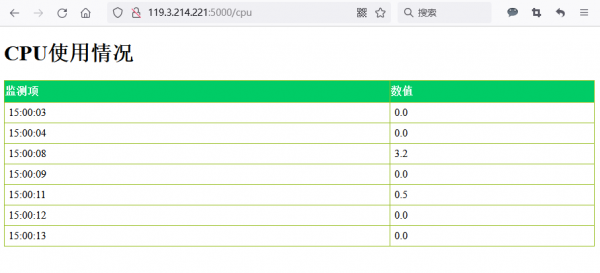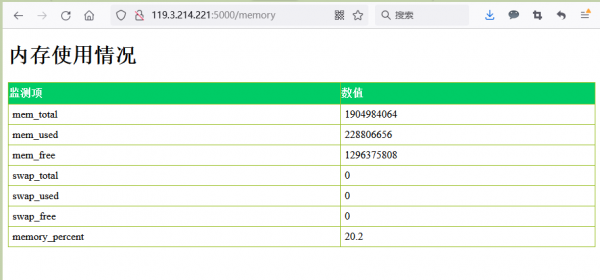“Psutil + Flask开发Linux /Windows系统监控”的版本间的差异
来自CloudWiki
| 第25行: | 第25行: | ||
==获取系统信息== | ==获取系统信息== | ||
===初始化=== | ===初始化=== | ||
| + | app.py: | ||
| + | |||
<nowiki> | <nowiki> | ||
| 第94行: | 第96行: | ||
cpu_percent_dict.pop(list(cpu_percent_dict.keys())[0]) | cpu_percent_dict.pop(list(cpu_percent_dict.keys())[0]) | ||
| − | return render_template('list.html', title="CPU使用情况",my_dict=cpu_percent_dict)</nowiki> | + | return render_template('list.html', title="CPU使用情况",my_dict=cpu_percent_dict) |
| + | |||
| + | if __name__ == '__main__':#程序入口 | ||
| + | #app.run()#让应用运行在本地服务器上。 | ||
| + | app.run(debug=True,host='0.0.0.0') #允许任意网址访问本站 | ||
| + | </nowiki> | ||
[[文件:python2022052702.png|600px]] | [[文件:python2022052702.png|600px]] | ||
| 第115行: | 第122行: | ||
return render_template('list.html', title="内存使用情况",my_dict=sys) | return render_template('list.html', title="内存使用情况",my_dict=sys) | ||
| − | + | ||
| − | |||
| − | |||
</nowiki> | </nowiki> | ||
| 第142行: | 第147行: | ||
===app.py=== | ===app.py=== | ||
<nowiki> | <nowiki> | ||
| + | import psutil | ||
import os, signal | import os, signal | ||
from random import randrange | from random import randrange | ||
from flask import Flask, render_template, jsonify, request | from flask import Flask, render_template, jsonify, request | ||
| − | |||
| − | |||
| − | |||
| − | |||
import time | import time | ||
| − | |||
app = Flask(__name__, static_folder="templates") | app = Flask(__name__, static_folder="templates") | ||
| 第159行: | 第160行: | ||
disk_dict = {'disk_time':[], 'write_bytes': [], 'read_bytes': [], 'pre_write_bytes': 0, 'pre_read_bytes': 0, 'len': -1} | disk_dict = {'disk_time':[], 'write_bytes': [], 'read_bytes': [], 'pre_write_bytes': 0, 'pre_read_bytes': 0, 'len': -1} | ||
| + | cpu_percent_dict = {} | ||
| + | |||
| + | @app.route("/cpu") | ||
def cpu(): | def cpu(): | ||
| − | now = time.strftime('%H:%M:%S', time.localtime(time.time())) | + | for i in range(1,6): |
| − | + | # 当前时间 | |
| − | + | now = time.strftime('%H:%M:%S', time.localtime(time.time())) | |
| + | # CPU 负载 | ||
| + | cpu_percent = psutil.cpu_percent() | ||
| + | cpu_percent_dict[now] = cpu_percent | ||
| + | time.sleep(0.3) | ||
| + | |||
# 保持在图表中 10 个数据 | # 保持在图表中 10 个数据 | ||
if len(cpu_percent_dict.keys()) == 11: | if len(cpu_percent_dict.keys()) == 11: | ||
cpu_percent_dict.pop(list(cpu_percent_dict.keys())[0]) | cpu_percent_dict.pop(list(cpu_percent_dict.keys())[0]) | ||
| + | return render_template('list.html', title="CPU使用情况",my_dict=cpu_percent_dict) | ||
| − | + | @app.route("/memory") | |
| − | |||
| − | |||
| − | |||
| − | |||
| − | |||
| − | |||
| − | |||
| − | |||
| − | |||
| − | |||
| − | |||
def memory(): | def memory(): | ||
memory = psutil.virtual_memory() | memory = psutil.virtual_memory() | ||
swap = psutil.swap_memory() | swap = psutil.swap_memory() | ||
| − | + | sys={} | |
| − | + | sys['mem_total']= memory.total | |
| + | sys['mem_used']= memory.used | ||
| + | sys['mem_free']= memory.free | ||
| + | sys['swap_total']=swap.total | ||
| + | sys['swap_used']=swap.used | ||
| + | sys['swap_free']=swap.free | ||
| + | sys['memory_percent']= memory.percent | ||
| + | return render_template('list.html', title="内存使用情况",my_dict=sys) | ||
| − | + | if __name__ == '__main__':#程序入口 | |
| − | + | #app.run()#让应用运行在本地服务器上。 | |
| − | + | app.run(debug=True,host='0.0.0.0') #允许任意网址访问本站 | |
| − | |||
| − | |||
| − | |||
| − | |||
| − | |||
| − | |||
| − | |||
| − | |||
| − | |||
| − | |||
| − | |||
| − | |||
| − | |||
| − | |||
| − | |||
| − | # | ||
| − | |||
| − | |||
| − | |||
| − | |||
| − | |||
| − | |||
| − | |||
| − | |||
| − | |||
| − | |||
| − | |||
| − | |||
| − | |||
| − | |||
| − | |||
| − | |||
| − | |||
| − | |||
| − | |||
| − | |||
| − | |||
| − | |||
| − | |||
| − | |||
| − | |||
| − | |||
| − | |||
| − | |||
| − | |||
| − | |||
| − | |||
| − | |||
| − | |||
| − | |||
| − | |||
| − | |||
| − | |||
| − | |||
| − | |||
| − | |||
| − | |||
| − | |||
| − | |||
| − | |||
| − | |||
| − | |||
| − | |||
| − | |||
| − | |||
| − | |||
| − | |||
| − | |||
| − | |||
| − | |||
| − | |||
| − | |||
| − | |||
| − | |||
| − | |||
| − | |||
| − | |||
| − | |||
| − | |||
| − | |||
| − | |||
| − | |||
| − | |||
| − | |||
| − | |||
| − | |||
| − | |||
| − | |||
| − | |||
| − | |||
| − | |||
| − | |||
| − | |||
| − | |||
| − | |||
| − | |||
| − | |||
| − | |||
| − | |||
| − | |||
| − | |||
| − | |||
| − | |||
| − | |||
| − | |||
| − | |||
| − | |||
| − | |||
| − | |||
| − | |||
| − | |||
| − | |||
| − | |||
| − | |||
| − | |||
| − | |||
| − | |||
| − | |||
| − | |||
| − | |||
| − | |||
| − | |||
| − | |||
| − | |||
| − | |||
| − | |||
| − | |||
| − | |||
| − | |||
| − | |||
| − | |||
| − | |||
| − | |||
| − | |||
| − | |||
| − | |||
| − | |||
| − | |||
| − | |||
| − | |||
| − | |||
| − | |||
| − | |||
| − | |||
| − | |||
| − | |||
| − | |||
| − | |||
| − | |||
| − | |||
| − | |||
| − | |||
| − | |||
| − | |||
| − | |||
| − | |||
| − | |||
| − | |||
| − | |||
| − | |||
| − | |||
| − | |||
| − | |||
| − | |||
| − | |||
| − | |||
| − | |||
| − | |||
| − | |||
| − | |||
| − | |||
| − | |||
| − | |||
| − | |||
| − | |||
| − | |||
| − | |||
| − | |||
| − | |||
| − | |||
| − | |||
| − | |||
| − | |||
| − | |||
| − | |||
| − | |||
| − | |||
| − | |||
| − | |||
| − | |||
| − | |||
| − | |||
| − | |||
| − | |||
| − | |||
| − | |||
| − | |||
| − | |||
| − | |||
| − | |||
| − | |||
| − | |||
| − | |||
| − | |||
| − | |||
| − | |||
| − | |||
| − | |||
| − | |||
| − | |||
| − | |||
| − | |||
| − | |||
| − | |||
| − | |||
| − | |||
| − | |||
| − | |||
| − | |||
| − | |||
</nowiki> | </nowiki> | ||
| − | ===templates/ | + | ===templates/list.html=== |
| + | templates/list.html: | ||
<nowiki> | <nowiki> | ||
| 第432行: | 第219行: | ||
<table id="customers" class="table table-striped"> | <table id="customers" class="table table-striped"> | ||
<tr> | <tr> | ||
| − | <th> | + | <th>监测项</th> |
| − | <th> | + | <th>数值</th> |
</tr> | </tr> | ||
| 第443行: | 第230行: | ||
{% endfor %} | {% endfor %} | ||
</table> | </table> | ||
| − | </body | + | </body></nowiki> |
| − | |||
==效果== | ==效果== | ||
| − | [[文件: | + | [[文件:python2022052702.png|600px]] |
| + | |||
| + | [[文件:python2022052701.png|600px]] | ||
参考文档 : https://blog.csdn.net/ityouknow/article/details/105985451 | 参考文档 : https://blog.csdn.net/ityouknow/article/details/105985451 | ||
2022年5月28日 (六) 04:14的版本
目录
简介
psutil 是一个跨平台库(http://pythonhosted.org/psutil)能够获取到系统运行的进程和系统利用率(包括CPU、内存、磁盘、网络等)信息。主要用来做系统监控,性能分析,进程管理。支持 Linux、Mac OS、Windows 系统。
本文以 psutil 模块获取系统信息开发一个监控 Windows 系统的平台。
技术选择
- 监控的系统是 Windows 系统
- 监控系统模块选择 psutil 模块
- Web 框架选择的是 Flask 框架
技术准备
安装 psutil
pip3 install psutil
安装 Flask、pyecharts、Bootstrap
Flask 的教程是在公众号文章:Web 开发 Flask 介绍
获取系统信息
初始化
app.py:
import psutil
import os, signal
from random import randrange
from flask import Flask, render_template, jsonify, request
import time
app = Flask(__name__, static_folder="templates")
cpu_percent_dict = {}
net_io_dict = {'net_io_time':[], 'net_io_sent': [], 'net_io_recv': [], 'pre_sent': 0, 'pre_recv': 0, 'len': -1}
disk_dict = {'disk_time':[], 'write_bytes': [], 'read_bytes': [], 'pre_write_bytes': 0, 'pre_read_bytes': 0, 'len': -1}
cpu_percent_dict = {}
网页模板
templates/list.html:
<!DOCTYPE html>
<html lang="zh-CN">
<head>
<meta charset="utf-8">
<meta http-equiv="X-UA-Compatible" content="IE=edge">
<meta name="viewport" content="width=device-width, initial-scale=1">
<title>基于psutil的系统监控工具</title>
<link href="https://cdn.jsdelivr.net/npm/bootstrap@3.3.7/dist/css/bootstrap.min.css" rel="stylesheet">
</head>
<body>
<h1>{{title}}</h1>
<table id="customers" class="table table-striped">
<tr>
<th>监测项</th>
<th>数值</th>
</tr>
{% for key, value in my_dict.items() %}
<tr>
<td>{{ key }}</td>
<td>{{ value}}</td>
</tr>
{% endfor %}
</table>
</body>
</html>
CPU信息
通过 psutil 获取 CPU 信息
@app.route("/cpu")
def cpu():
for i in range(1,6):
# 当前时间
now = time.strftime('%H:%M:%S', time.localtime(time.time()))
# CPU 负载
cpu_percent = psutil.cpu_percent()
cpu_percent_dict[now] = cpu_percent
time.sleep(0.3)
# 保持在图表中 10 个数据
if len(cpu_percent_dict.keys()) == 11:
cpu_percent_dict.pop(list(cpu_percent_dict.keys())[0])
return render_template('list.html', title="CPU使用情况",my_dict=cpu_percent_dict)
if __name__ == '__main__':#程序入口
#app.run()#让应用运行在本地服务器上。
app.run(debug=True,host='0.0.0.0') #允许任意网址访问本站
内存
@app.route("/memory")
def memory():
memory = psutil.virtual_memory()
swap = psutil.swap_memory()
sys={}
sys['mem_total']= memory.total
sys['mem_used']= memory.used
sys['mem_free']= memory.free
sys['swap_total']=swap.total
sys['swap_used']=swap.used
sys['swap_free']=swap.free
sys['memory_percent']= memory.percent
return render_template('list.html', title="内存使用情况",my_dict=sys)
效果:
https://blog.csdn.net/ityouknow/article/details/105985451
磁盘
通过 psutil 获取磁盘大小、分区、使用率和磁盘IO
网卡
通过 psutil 获取网络接口和网络连接的信息
代码
app.py
import psutil
import os, signal
from random import randrange
from flask import Flask, render_template, jsonify, request
import time
app = Flask(__name__, static_folder="templates")
cpu_percent_dict = {}
net_io_dict = {'net_io_time':[], 'net_io_sent': [], 'net_io_recv': [], 'pre_sent': 0, 'pre_recv': 0, 'len': -1}
disk_dict = {'disk_time':[], 'write_bytes': [], 'read_bytes': [], 'pre_write_bytes': 0, 'pre_read_bytes': 0, 'len': -1}
cpu_percent_dict = {}
@app.route("/cpu")
def cpu():
for i in range(1,6):
# 当前时间
now = time.strftime('%H:%M:%S', time.localtime(time.time()))
# CPU 负载
cpu_percent = psutil.cpu_percent()
cpu_percent_dict[now] = cpu_percent
time.sleep(0.3)
# 保持在图表中 10 个数据
if len(cpu_percent_dict.keys()) == 11:
cpu_percent_dict.pop(list(cpu_percent_dict.keys())[0])
return render_template('list.html', title="CPU使用情况",my_dict=cpu_percent_dict)
@app.route("/memory")
def memory():
memory = psutil.virtual_memory()
swap = psutil.swap_memory()
sys={}
sys['mem_total']= memory.total
sys['mem_used']= memory.used
sys['mem_free']= memory.free
sys['swap_total']=swap.total
sys['swap_used']=swap.used
sys['swap_free']=swap.free
sys['memory_percent']= memory.percent
return render_template('list.html', title="内存使用情况",my_dict=sys)
if __name__ == '__main__':#程序入口
#app.run()#让应用运行在本地服务器上。
app.run(debug=True,host='0.0.0.0') #允许任意网址访问本站
templates/list.html
templates/list.html:
<!DOCTYPE html>
<html lang="zh-CN">
<head>
<meta charset="utf-8">
<meta http-equiv="X-UA-Compatible" content="IE=edge">
<meta name="viewport" content="width=device-width, initial-scale=1">
<title>基于psutil的系统监控工具</title>
<link href="https://cdn.jsdelivr.net/npm/bootstrap@3.3.7/dist/css/bootstrap.min.css" rel="stylesheet">
</head>
<body>
<h1>{{title}}</h1>
<table id="customers" class="table table-striped">
<tr>
<th>监测项</th>
<th>数值</th>
</tr>
{% for key, value in my_dict.items() %}
<tr>
<td>{{ key }}</td>
<td>{{ value}}</td>
</tr>
{% endfor %}
</table>
</body>
效果
参考文档 : https://blog.csdn.net/ityouknow/article/details/105985451

